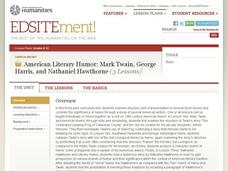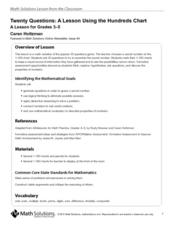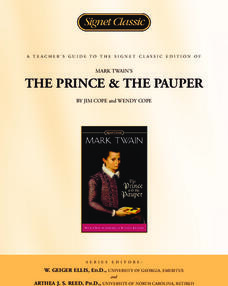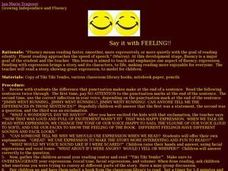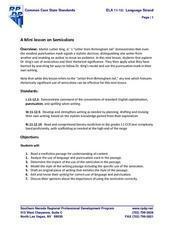Student Achievement Partners
"The Glorious Whitewasher" from The Adventures of Tom Sawyer by Mark Twain with Mini-Assessment
It's the classic scene: Tom Sawyer is whitewashing a fence. Expose your learners to Mark Twain's humor while reinforcing reading comprehension. Eighth graders are encouraged to read and reread, achieving as much exposure to the text as...
National Endowment for the Humanities
American Literary Humor: Mark Twain, George Harris, and Nathaniel Hawthorne
Nathaniel Hawthorne as a humorist? Really? The three lessons in this series focus on the the storytelling style, conventions, and literary techniques employed by Hawthorne, George Washington Harris, and Mark Twain.
EngageNY
Reading for Gist and Answering Text-Dependent Questions: Chapter 5 of World without Fish
Discover the rules of fishing. Pupils read chapter five of World without Fish to discover ideas about the rules and laws of fishing. They use sticky notes to annotate text as they read about fishing in other countries. They focus on the...
Penguin Books
A Teacher's Guide to the Signet Classics Edition of Mark Twain's The Adventures of Huckleberry Finn
Whether new to teaching The Adventures of Huckleberry Finn or an experienced pro, you’ll find useful resources in this teacher’s guide. The 40-page packet includes background information, historical context, an annotated list of...
What So Proudly We Hail
The Meaning of America: Enterprise and Commerce
Using Mark Twain's The Man That Corrupted Hadleyburg, invite your learners to consider the concept of virtue in a democratic society devoted to gain and self-interest. This stellar resource guides your class members through a close...
Curated OER
Mark Twain and Huckleberry Finn Introductory Lessons
“What is the role or function of controversial art? And, should children, our children, be required—forced—to study certain works they may find painful or humiliating or offensive?” Robert Zalisk’s question, found in his article, “Uproar...
Curated OER
Twenty Questions: The Hundred Chart
Use the 20 Questions game to practice math vocabulary and number properties! Project a hundreds chart and hand one out to learners. Ideally, give them counters (beans would work well) to mark off the chart so you can play multiple times....
Penguin Books
A Teacher's Guide to the Signet Classic Edition of Mark Twain's The Prince and The Pauper
Imagine how the world would be different if all diplomats' children were required to serve in the military. Or if all high school graduates were required to do two years of community service before post-secondary education. A 30-page...
Curated OER
The Adventures of Tom Sawyer: "Chalk Talk Strategy”
Hold a silent discussion about concepts related to The Adventures of Tom Sawyer. After reading chapter seven, learners participate in a whole-class written discussion based on guiding questions written on the board by the teacher.
Novelinks
The Adventures of Tom Sawyer: Cubing Strategy
The toss of a die determines what questions your pupils will answer in this lesson. Learners respond to questions based on Bloom's taxonomy, discussing The Adventures of Tom Sawyer with classmates along the way. They finish by writing up...
Curated OER
Communication Skills: Special Education
Get to talking with your special needs class. In pairs, they take turns telling each other where to go on a schematic map. They work to ask questions, answer questions, and check if their partner understands their directions, or if he...
K12 Reader
Punctuation Theater
Break out the slide whistles, triangles, and tambourines. It's time for a punctuation lesson. This richly detailed plan is loaded with ideas and activities for using rhythm instruments to accent the punctuation in folk tales. A great way...
US Department of State
Reader's Theater: The Adventures of Tom Sawyer
The opening chapters of Mark Twain's masterpiece, The Adventures of Tom Sawyer, can be daunting for some readers. A reader's theater assignment divides the second chapter of the novel into a seven-role script, allowing readers to work...
Great Books Foundation
Discussion Guide for Handmaid's Tale
Great literature discussions are a consequence of carefully crafted questions, interpretative questions that permit more than one response, and responses supported by specific evidence from the text. The discussion questions in a guide...
Curated OER
Gallery Walk Questions on Earth's Radiation Balance
Questions that can be used in a lesson on Earth's radiation balance are suggested in this resource. It is not a lesson plan, per se, but it is a list of questions for stations within a "Gallery Walk" lesson. The link to how Gallery Walks...
EngageNY
Contrasting Two Settings (Chapter 6: "Lost Melones/Cantalouples")
Continue working through Esperanza Rising, by Pam Munoz Ryan, by looking into language choices and discussing text-dependent questions. Pupils converse in small groups and as a class about plot, setting, and figurative language. Using...
EngageNY
Getting to Know Esperanza (Chapter 2: “Las Uvas/Grapes”)
Delve into Esperanza Rising by Pam Muñoz Ryan with close reading and evidence-based, text-dependent questions. Part of a unit series, this well-sequenced, Common Core designed instructional activity draws on material from the previous...
Curated OER
The Glorious Whitewasher
Young readers can be exposed to the literary works of Mark Twain as they interact with challenging text and gain experience by reading the complex passages of chapter two "The Glorious Whitewasher" from his famous book, The Adventures of...
Howard Hughes Medical Institute
Human Feet Are Strange
Feet are neat! So, if you've already walked the path of examining animal footprints with your class, put them in the shoes of early humans! A well-designed lesson incorporates video, discussion, and hands-on learning to demonstrate how...
Curated OER
Pudd'nhead Wilson: K-W-H-L
Prejudice is the theme of this Pudd'nhead Wilson KWHL chart. Learners fill out their charts, discuss how to find the answers to their questions, and spend some time researching a topic they want to know more about.
Curated OER
Say it with FEELING!
Why should we read with expression when we read? Engage your learners in this discussion and teach them the easiest way to gauge expression: the end mark! Is it a question mark? An exclamation point? This helps you determine how to...
Southern Nevada Regional Professional Development Program
A Mini lesson on Semicolons
Dr. Martin Luther King, Jr.'s "Letter from Birmingham Jail" serves as an exemplar for a mini-lesson on semicolons. Working alone or in small groups, class members first circle all the semicolons in the letter, and then consider how this...
Education Development Center
Area Model Factoring
Introduce learners to what factoring represents and it's relationship to a square with a resource about factoring and the method of area models. The questions are scaffolded to begin with introductory questions and eventually have...
It's About Time
Refraction of Light
Don't shine like a diamond, refract light like a diamond. Young scientists use an acrylic block and a laser light to observe refraction. Advanced scholars figure the sine of the angles of reflection and incidence as well as mastering...
Other popular searches
- Periods and Question Marks
- Teaching Question Marks
- Question Mark Activities
- Punctuation Question Marks
- Punctuation Question Marks
- Question Mark Practice
- Period Question Mark
- Using Question Marks
- Identify Question Mark
- Language Arts Question Mark
- Periods Question Marks
- Punctuation Question Mark



